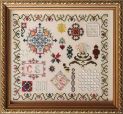|
Blackwork is assumed to have been introduced into Britain by Catherine of Aragon when
she married Henry VIII in 1509. It was first used for dress decoration, particularly on the
full sleeves of ladies gowns. Eventually, this intricate form of needlework was used for
household items, bed linens, cushions etc. Many of the traditional geometric designs
display arabesques and stylized "eastern" motifs, often resembling grillwork. They show
a strong Islamic influence, borrowing heavily from Moorish motifs that filtered from Africa
through Spain onto the rest of the Continent and the British Isles.
Blackwork was, as its name suggests, originally worked in black thread, with the occasional
use of gold or silver thread to give added interest. Designs were first outlined with stem,
back, chain or Holbein stitch (running back stitch) and then filled with the intricate lace-like
patterns.
Today,although any color thread may be used, the integrity of the technique has generally
been preserved. Broader affects can be acheived with the use of the newer fibers available
to us, varying the thickness of the threads, the density of patterning which gives the subtle
effect of light and shade. Outlining can be partially or totally omitted, allowing the patterning
to break free from previous restraints.
|
